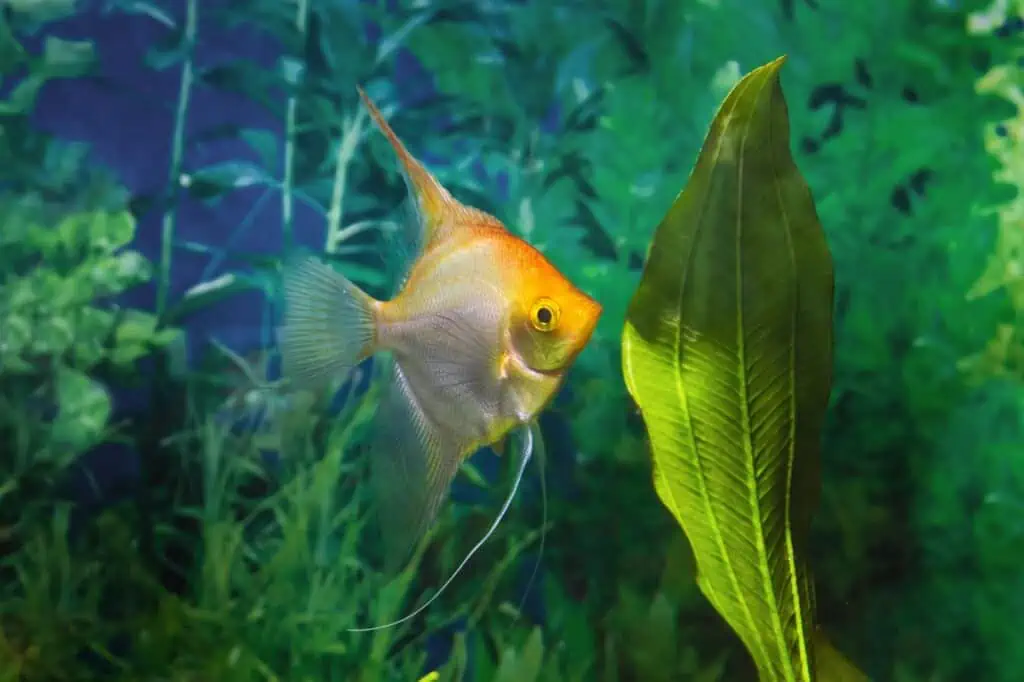Whether you term angelfish ‘social fish’ or ‘schooling fish‘, it’s clear that they tend to enjoy the company of one another and should ideally be kept in pairs or groups.
In no circumstances should an angelfish be kept completely isolated, though some aquarists have successfully kept a single specimen alongside other fish in a community tank.
But what is the ideal number of angelfish, and what qualities should you look for in tank mates for angelfish? Let’s find out!
Reasons Why Angelfish Should Be Kept In Groups
Angelfish Are Cichlids!
The first reason that angelfish should never be kept alone is the fact they are cichlids. Many people seem to equate cichlids with the aggressive species of the East African lakes, but peaceful South American species like Angelfish, Discus, and Severums are also in the family.
Cichlids are incredibly intelligent fish that exhibit highly advanced social behavior and interaction. To keep an angelfish in a tank all on its own would be incredibly cruel, and your miserable-looking angelfish surely wouldn’t bring you much satisfaction either.
Without social contact with other angelfish or community tank species, your angelfish would likely become depressed and die prematurely from a stress-related health condition.
Angelfish Are Schooling Fish
There seems to be some debate on the internet about whether angelfish should be classed as ‘schooling fish’. While they can live happily in pairs in captivity, in the wild they would naturally spend time in larger groups.
To clear this issue up, I’ve retrieved a revealing video from the Amazon that shows these wonderful fish living in their natural habitat.
I found it amazing to see how many angelfish are sticking together in what could be termed loosely formed schools, and not without good reason!
Check out the larger, predatory-looking fish move in as the video progresses – some type of perch, I’m guessing.
Angelfish Like to Breed In Captivity
One of the wonders of keeping angelfish at home is the potential for them to reproduce!
The courting behavior of these cichlids is fascinating to watch. Locking lips, the larger male will often push and pull the female around in the water to induce spawning.
Eggs are normally laid on a vertical surface such as a piece of driftwood or slate. The best angelfish parents will fan the eggs with their fins and defend them vigilantly against other fish.
Young, inexperienced parents, however, will often eat their own eggs, especially if they feel stressed by other fish in the aquarium.
This has led many angelfish breeders to remove the eggs from the parent’s tank and into a specialized breeding tank where the fry can grow up without the risk of predation.
Male vs Female Angelfish
Once you’ve got your angelfish, one of your first questions will be: are they male or female?
While young angels can be difficult to sex, differences between the genders begin to emerge as they grow older.
Male angelfish tend to be more aggressive, grow up to one-third larger than female angelfish, and have a ‘nuchal hump’ on their forehead.
Their body shape is more round than a female’s, and their ventral fins tend to be forked or frayed rather than having a single tip.
Most reliably of all, the sex of adult angelfish can be distinguished by their genitalia. Whereas females have a blunt ovipositor tube on their underside, the male’s breeding tube is thin and pointed.
Keeping Angelfish Alone In a Community Tank
Because angelfish can become more aggressive towards their tank mates during spawning, some people will occasionally choose to prevent breeding by keeping one alone within a community tank.
While these types of fish probably won’t be as happy as when they have companions of the same breed around, the company of other fish will help your angel feel stimulated.
The ideal candidates for compatible tank mates are peaceful fish that are large enough to defend themselves from your angels.
Angels can be quite territorial fish, and are also omnivorous, meaning they might try to eat anything they can fit in their mouths!
Whether you’re keeping your angelfish in a school or alone in a community tank, here are some great tropical fish species to keep alongside them:
Good Tankmates for Angelfish
Cardinal Tetra
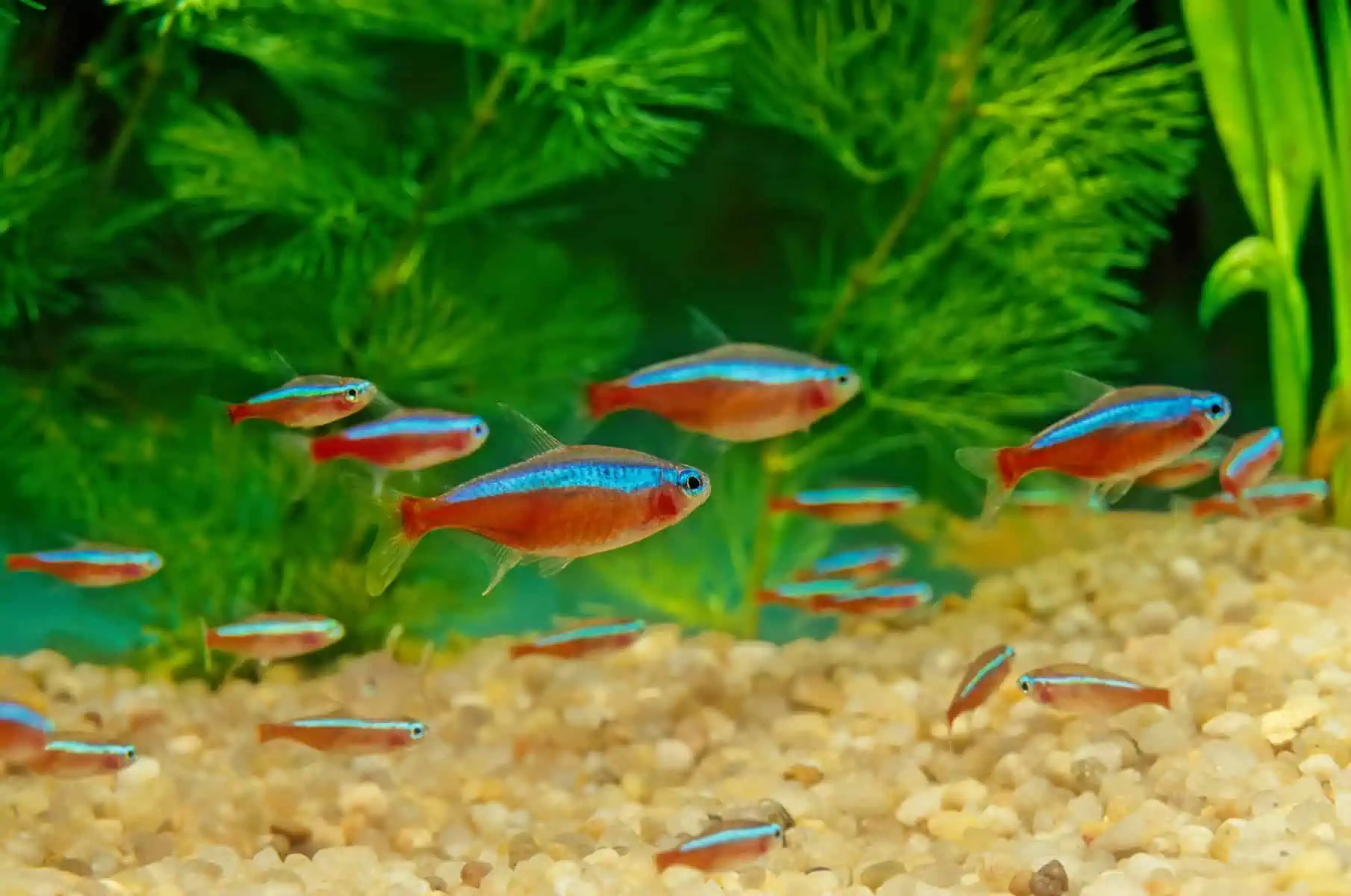
When keeping angelfish in a community aquarium, many people like to choose other species that also come from the Amazon.
Neon tetra are a popular choice for Amazon-themed aquariums, but are so small that they might become lunch for angelfish as they get bigger!
A better choice is the slightly larger cardinal tetra. They are otherwise similar to neon tetra and look just as beautiful when kept in a large school. Just make sure that your water is soft, acidic, and kept clean for these little fish to thrive.
Ram Cichlids (Mikrogeophagus ramirezi)
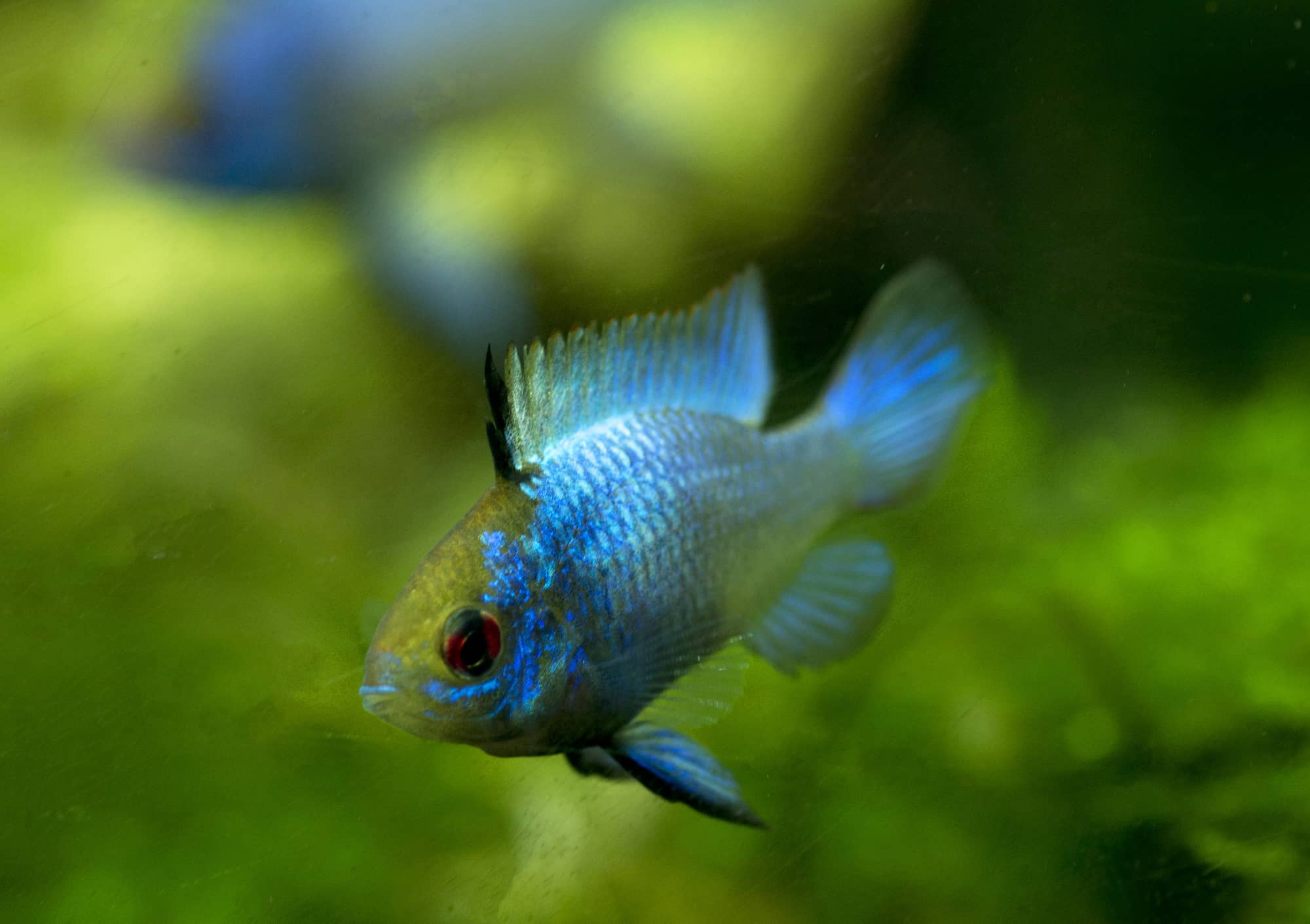
Although most species of cichlid are too aggressive to keep with angelfish, ram cichlids are an exception. These peaceful dwarfs are intelligent, colorful, and a joy to watch.
They also tend to swim near the bottom of the tank, so they won’t interfere too much with your fish’s territory.
Coming from Central America, their native range isn’t far from that of the angelfish, and the two species enjoy similar water parameters.
Giant Danios

While they don’t grow to enormous sizes themselves, giant danios are ideal tank mates for large fish. Because they’re so fast and agile, these active fish don’t make easy targets for other fish and are a hardy and peaceful species towards other tank members.
Even if you have fairly aggressive angelfish, the speedy giant danio should be able to stay out of harm’s way.
Corydoras Catfish
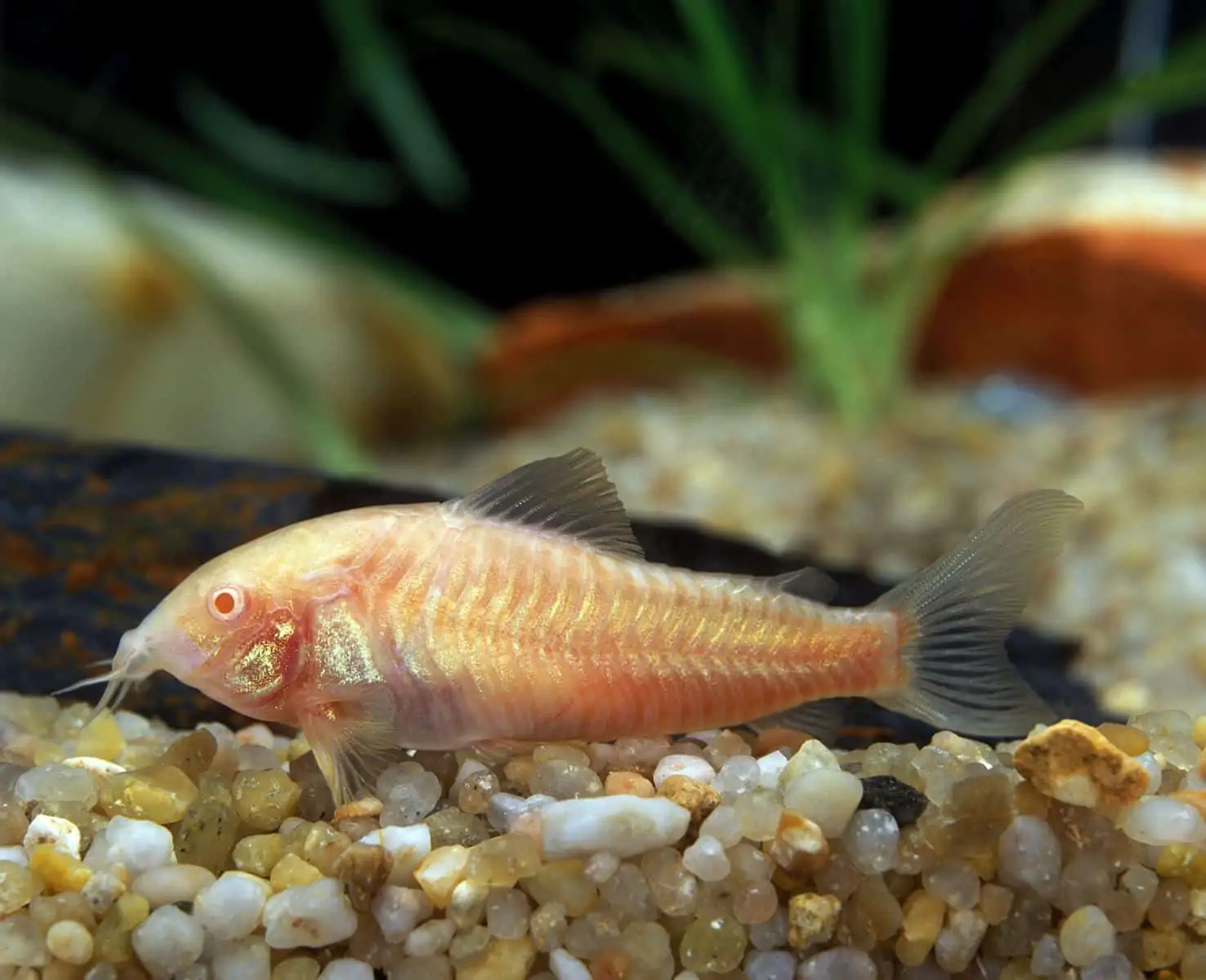
Cory catfish are a winner for almost every type of community tank setup. Their peaceful nature and ability to help keep a tank clean make them an ever-popular choice. The fact that many species also come from the Amazon basin makes them especially suitable for an angelfish tank.
If you do decide to keep cories, make sure you keep them in a school of six or more since these fish would rarely be found alone in the wild.
Bristlenose Pleco

I mentioned that cory catfish are useful at keeping an aquarium clean, but few fish clean up algae as effectively as plecos.
Often referred to as ‘algae eaters’, plecos spend most of their time latched onto rocks, plants, and your tank’s glass, using their sucker mouths to hoover up all types of algae.
While many plecos will grow too large for the average-sized aquarium, bristlenose plecos only reach 4-6 inches in size, making them ideal companions for most angelfish tanks.
Incompatible Tankmates For Angelfish
While there is an abundance of tropical freshwater fish that you could successfully keep with angels, there are also a few that are unlikely to work out so well.
Because they have long fins, Angelfish should never be kept with other types of fish that are known to be ‘fin nippers’.
Barb species such as tiger barbs are notorious for this, but many types of tetra may also nip fins from time to time.
Serpae tetra, Blue tetras, White spot tetras, Buenos Aires tetras, Blind cavefish, and Black widow tetra are all on the black list, and even neon tetra may nip fins when they’re feeling stressed.
Fin nipping in tetras can, however, often be reduced by keeping them in larger schools and by improving their living conditions.
While some people have recommended Silver Dollars as good tank mates for Angelfish, their tendency to rip apart aquarium plants means they’re unsuitable for Amazon-themed tanks with the heavily planted aquascapes that angelfish love.
Angelfish Tank Size
Of course, one of the big questions you have to ask when considering the number of angelfish you’d like to keep is- how big is your tank?
While a pair of Angelfish could be kept in a 25-gallon tank, you’d need a 55-gallon tank to host 4 of them, and a 75-gallon aquarium to keep 6.
Additionally, you’ll need to add a gallon of volume for every additional one inch of other fish you keep in the tank.
For example, if you wanted to keep a pair of angelfish with six cardinal tetras, you’d need to make the following calculation:
Tank size for two angelfish = 25 gallons + Tank size for six 2-inch cardinal tetras (6×2 =12 gallons)
Meaning: 25 + 12 = 37 – a 40-gallon tank would be ideal!
The Ideal Number Of Angelfish
To begin with, many experienced specialists recommend 6 or 8 fish as the ideal number. That’s because angelfish like to form pairs, but can be a little unpredictable with who they choose to pair.
Starting with 6 or 8 young fish means that you’re almost certain to have a mixed group of males and females, and the fish will be able to freely choose their mates from the group.
If you don’t want to keep so many angelfish, but still like the idea of breeding them, you could try to find an already mated pair.
Mated angelfish pairs are always more expensive, though, and moving them from one tank to another can cause them stress, which might interrupt their courtship.
You should always purchase pairs from a reputable source, and try to make their transition as smooth as possible so that they’ll continue breeding in your aquarium.
How Much Do Mated Pairs Of Angelfish Cost?
As previously mentioned, mated pairs will always be more expensive than buying two single angelfish. For most varieties of angels, you might be able to find a pair for between $40-$80.
For rarer strains like true altums, you could be looking at anything up to $1000!
Creating an Amazonian Themed Tank
Because there are so many wonderful species that come from the Amazon, some aquarists have made Amazonian-themed aquariums. They often contain angelfish alongside other species that they would naturally swim alongside in the wild.
To create an Amazon river biotope that angelfish will love, you need to have soft, acidic water. If your tap water isn’t already soft and acidic, you’ll need to add pieces of driftwood or tree leaves such as Indian Almond Leaves to the bottom of the tank to release tannins.
Tannins make the water more acidic and turn an amber-brown color. Some people also believe that tannins improve the health of their fish.
This is most likely to be true of fish species that come from the Amazon and would naturally live in water containing tannins.
Plants For Angelfish
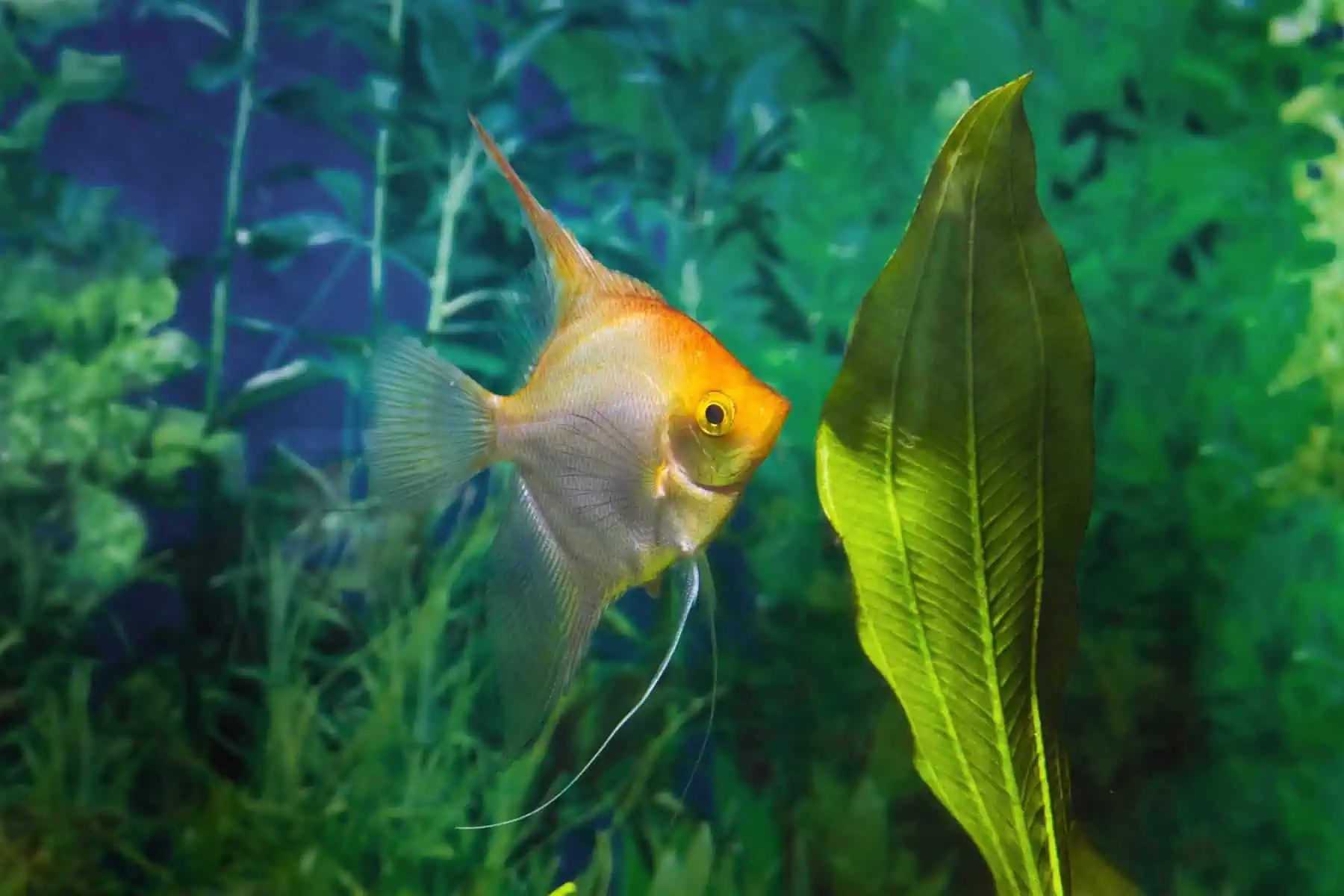
Angelfish simply love swimming around among plants as they would do in the wild. Live plants can also improve your water quality, and add a wealth of beauty to your tank.
If you’re creating an Amazonian-style tank, then go for plants that come from the Amazon basin such as Echinodorus (Amazon Sword, Dwarf Sword, etc.), Brazilian Water Ivy, Water Stargrass, Watermilfoil, Christmas Tree Plant, Pygmy Chain, or Amazon Grass Plant.
If you’ve noticed that some of the more tender leaves are getting eaten, however, you could go for some super tough plants from other parts of the world such as Java Fern, Java Moss, and Anubias.
Conclusion
Angelfish should never be kept entirely alone. To do so would be to deprive these intelligent fish of much-needed social interaction that’s essential to keep them feeling stimulated and healthy.
Ideally, angelfish should be kept with other angels, or at the very least with other peaceful community fish that have a proven record of living harmoniously alongside them.
Since a 75-gallon tank is an ideal size to keep a group of six angelfish, why not check out our buyer’s guide to these types of tanks here? We wish you great success in housing your angelfish!

